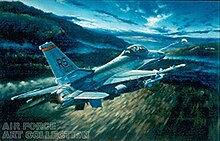The AIM-120 Advanced Medium-Range Air-to-Air Missile(AMRAAM) (pronounced AM-ram /æmɹæm/), is an American beyond-visual-range air-to-air missile capable of all-weather day-and-night operations. It uses active transmit-receive radar guidance instead of semi-active receive-only radar guidance. It is a fire-and-forget weapon, unlike the previous generation Sparrow missiles which required full guidance from the firing aircraft. When an AMRAAM missile is launched, NATO pilots use the brevity code "Fox Three".
This is a list of aviation-related events from 1994.
This is a list of aviation-related events from 1995.

Scott Francis O'Grady is a former United States Air Force fighter pilot. On June 2, 1995, he was shot down over Bosnia and Herzegovina by a 2K12 Kub mobile SAM launcher and forced to eject from his F-16C into hostile territory. US Marines from heavy-helicopter squadron HMH-464 and the 24 MEU(SOC) on AC number 21 eventually rescued O'Grady after nearly a week of his evading the Bosnian Serbs. He was previously involved in the Banja Luka incident where he fired upon six enemy aircraft. The 2001 film Behind Enemy Lines is loosely based upon his experiences.

Operation Deliberate Force was a sustained air campaign conducted by the North Atlantic Treaty Organization (NATO), in concert with the United Nations Protection Force (UNPROFOR) ground operations, to undermine the military capability of the Army of Republika Srpska (VRS), which had threatened and attacked UN-designated "safe areas" in Bosnia and Herzegovina during the Bosnian War with the Srebrenica genocide and Markale massacres, precipitating the intervention. The shelling of the Sarajevo marketplace on 28 August 1995 by the VRS is considered to be the immediate instigating factor behind NATO's decision to launch the operation.
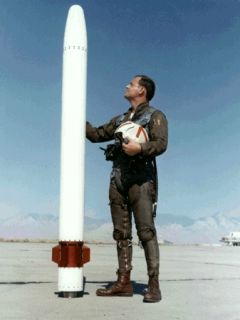
The AIM-95 Agile was an air-to-air missile developed by the United States. It was developed by the US Navy to equip the F-14 Tomcat, replacing the AIM-9 Sidewinder. Around the same time, the US Air Force was designing the AIM-82 to equip their F-15 Eagle, and later dropped their efforts to join the Agile program. In the end, newer versions of Sidewinder would close the performance gap so much that the Agile program was canceled.

Operation Deny Flight was a North Atlantic Treaty Organization (NATO) operation that began on 12 April 1993 as the enforcement of a United Nations (UN) no-fly zone over Bosnia and Herzegovina. The United Nations and NATO later expanded the mission of the operation to include providing close air support for UN troops in Bosnia and carrying out coercive air strikes against targets in Bosnia. Twelve NATO members contributed forces to the operation and, by its end on 20 December 1995, NATO pilots had flown 100,420 sorties.
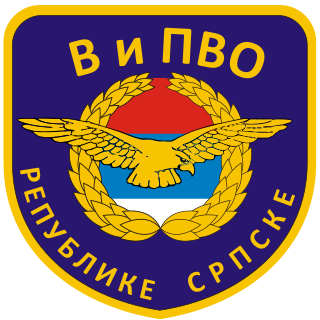
The Republika Srpska Air Force was the air force of Republika Srpska and was used primarily during the Bosnian war. In 2005, it was integrated into the Armed Forces of Bosnia and Herzegovina. SFOR still plays a large role in Bosnia and Herzegovina, which consists of the Federation of Bosnia and Herzegovina and Republika Srpska. Under the leadership of one president, the ministry of defense of both entities merged into one single ministry of defense with one chief of joint staff commanding both Air Forces. In 2004 there was again a restructuring of the armed forces, bringing the number of Air Force personnel down to 4,000. Next to the command, the 1st Regiment V i PVO consists out of a platoon, a radar battalion, artillery rocket ADF battalion, AF logistics battalion and aviation assets, a Fighter Bomber Squadron and Mixed Helicopter Squadron. In 2006 the Air Force of Republika Srpska was disbanded.
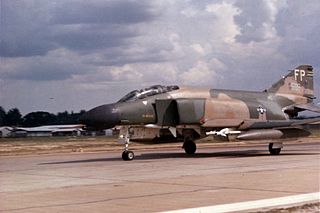
Operation Bolo was a United States Air Force mission during the Vietnam War, considered to be a successful combat ruse.

The Soko J-21 Jastreb, referred to as the J-1 Jastreb in some sources, is a Yugoslav single-seat, single-engine, light attack aircraft, designed by the Aeronautical Technical Institute (ATI) and Vojnotehnički Institut Beograd (VTI), in Belgrade and manufactured by SOKO in Mostar. Derived from the G-2 Galeb advanced jet trainer and light attack aircraft, it was designed in single-seat ground-attack and two-seat advanced flying / weapon training versions.

The AIM-9 Sidewinder is a short-range air-to-air missile. Entering service with the United States Navy in 1956 and the Air Force in 1964, the AIM-9 is one of the oldest, cheapest, and most successful air-to-air missiles. Its latest variants remain standard equipment in most Western-aligned air forces. The Soviet K-13, a reverse-engineered copy of the AIM-9B, was also widely adopted.

The NATO intervention in Bosnia and Herzegovina was a series of actions undertaken by NATO whose stated aim was to establish long-term peace during and after the Bosnian War. NATO's intervention began as largely political and symbolic, but gradually expanded to include large-scale air operations and the deployment of approximately 60,000 soldiers of the Implementation Force.
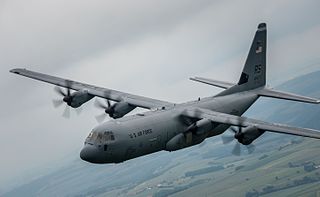
The 86th Operations Group is the flying operational component of the 86th Airlift Wing, United States Air Force. The group is stationed at Ramstein Air Base, Germany.

The 252nd Training Squadron "Ušće Wolves" is a squadron of the 204th Air Brigade of the Serbian Air Force and based at Batajnica Air Base.
The General Dynamics F-16 Fighting Falcon has served the United States and the air arms of 25 other nations. Over 4,400 F-16s have been sold.
During the 1991 Gulf War and subsequent operations in no-fly zones over Iraq, Coalition air forces faced the Iraqi Air Force (IQAF), the fourth largest air force in the world at the time. In the opening days of the war, many air-to-air engagements occurred, between Iraqi interceptors and a variety of different Coalition aircraft.

The 105th Aviation Brigade was formed from the disbanded Yugoslav 105th Fighter-Bomber Aviation Regiment in the spring of 1993 by the Serbian Army of Krajina at Udbina Airport. Its accurate organization is unknown, and it's not exactly clear whether the brigade was part of Republika Srpska Air Force, because the aircraft had same roundels.

On 27 March 1999, during the NATO bombing of Yugoslavia, a Yugoslav Army unit shot down an F-117 Nighthawk stealth aircraft of the United States Air Force by firing a S-125 Neva/Pechora surface-to-air missile. The pilot ejected safely and was rescued by U.S. Air Force PJs conducting search and rescue.

On 25 and 26 May 1995, NATO conducted air strikes against positions of the Army of Republika Srpska (VRS) at Pale, as part of Operation Deny Flight, during the Bosnian War.

On 21 November 1994, NATO aircraft taking part of Operation Deny Flight carried out an airstrike on the airbase of Udbina, Croatia, then part of the self-proclaimed Serbian Republic of Krajina. Krajina Serbs had been launching air attacks on neighbour Bosnia and Herzegovina from the base in support of allied Serbian forces there, specially during the battle of Bihac. NATO forces intervened in order to deter further attacks. Two anti-aircraft SA-2 missile sites that the Serbs had used to attack Bihac in the ground-to-ground mode and to engage NATO aircraft were also destroyed in the following days. The bombing of Udbina was the largest air combat operation in Europe since World War II, and the largest combat operation in NATO's history up to that time.
